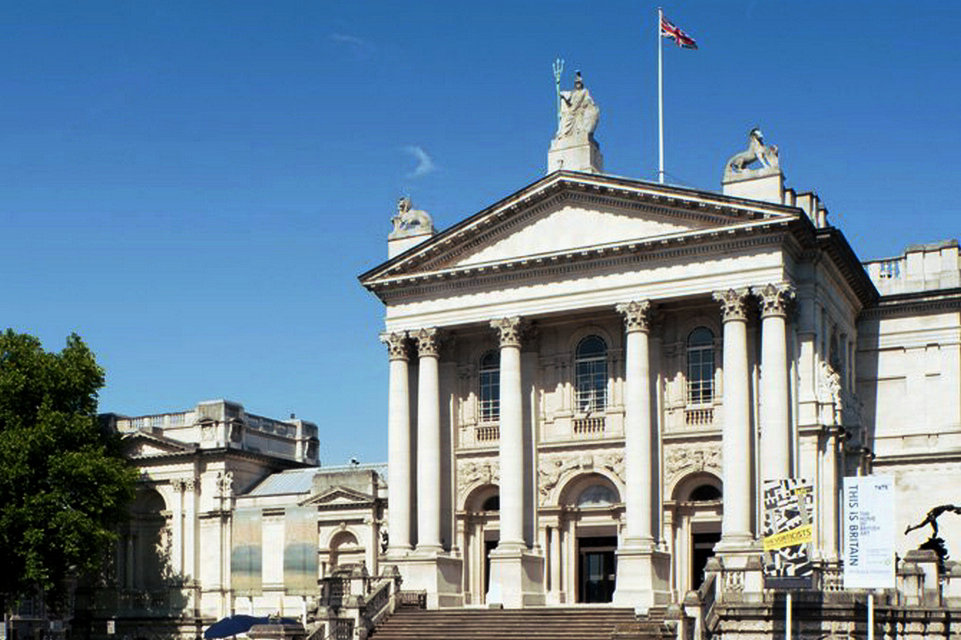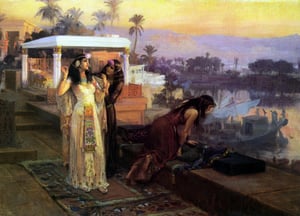Tate Britain (known from 1897 to 1932 as the National Gallery of British Art and from 1932 to 2000 as the Tate Gallery) is an art museum on Millbank in the City of Westminster in London It is part of the Tate network of galleries in England, with Tate Modern, Tate Liverpool and Tate St Ives It is the oldest gallery in the network, having opened in 1897 It houses a substantial collection of the art of the United Kingdom since Tudor times, and in particular has large holdings of the works of J M W Turner, who bequeathed all his own collection to the nation It is one of the largest museums in the country
When Tate first opened its doors to the public in 1897 it had just one site, displaying a small collection of British artworks Today Tate has four major sites and the national collection of British art from 1500 to the present day and international modern and contemporary art, which includes nearly 70,000 artworks A number of new developments are planned for Tate Modern, Tate Britain and Tate St Ives to ensure the galleries continue to expand
British art is represented by artists chosen for their contribution to its history and development, rather than their nationality alone. The collection has recently expanded its holdings of modern and contemporary artworks from Africa, Asia Pacific, Eastern Europe, Latin America, the Middle East and South Asia.
Tate’s art collection embraces all media, from painting, sculpture, drawing and prints to photography, film, video, installations and performance to archive material including letters, sketchbooks and manuscripts. Tate is committed to expanding the geographical remit of its collection. Tate does not allocate more of its funds to either historic or contemporary works, as it needs flexibility in order to react to the market and what is available. Potential acquisitions of contemporary art are considered by artists who have already made a significant contribution and have achieved national or international recognition.
The gallery is situated on Millbank, on the site of the former Millbank Prison. Construction, undertaken by Higgs and Hill, commenced in 1893, and the gallery opened on 21 July 1897 as the National Gallery of British Art. However, from the start it was commonly known as the Tate Gallery, after its founder Sir Henry Tate, and in 1932 it officially adopted that name. Before 2000, the gallery housed and displayed both British and modern collections, but the launch of Tate Modern saw Tate’s modern collections move there, while the old Millbank gallery became dedicated to the display of historical and contemporary British art. As a consequence, it was renamed Tate Britain in March 2000.
Sidney R.J. Smith was chosen as the architect for the new gallery. His design is the core building that we see today, a grand porticoed entranceway and central dome which resembles a temple. The statue of Britannia with a lion and a unicorn on top of the pediment at the Millbank entrance emphasised its function as a gallery of British art. The gallery opened its doors to the public in 1897, displaying 245 works in eight rooms from British artists dating back to 1790.
In 1889 Henry Tate, an industrialist who had made his fortune as a sugar refiner, offered his collection of British nineteenth-century art to the nation and provided funding for the first Tate Gallery.
Tate was a great patron of Pre-Raphaelite artists and his bequest of 65 paintings to the National Gallery included John Everett Millais’ Ophelia 1851–2 and J.W.Waterhouse’s The Lady of Shalott 1888. The bequest was turned down by the trustees because there was not enough space in the gallery.
A campaign was begun to create a new gallery dedicated to British art. With the help of an £80,000 donation from Tate himself, the gallery at Millbank, now known as Tate Britain, was built and opened in 1897. Tate’s original bequest of works, together with works from the National Gallery, formed the founding collection.
The arts and antiques dealers Sir Joseph Joel Duveen (1843–1908) and his son Lord Joseph Duveen (1869–1939) made significant financial contributions to the original gallery at Millbank. With their support, large extensions were added to the gallery including seven new rooms to display the Turner Bequest in 1910 and the Duveen Sculpture Galleries, the first galleries build specifically for sculpture in England.
Since its original opening, the Millbank site has had seven major building extensions. In its first 15 years the Millbank site more than doubled in size, including the addition of seven rooms designed by the architect W.H. Romaine-Walker and funded by the arts and antique dealer J.J.(Sir Joseph) Duveen, built to display the Turner Bequest.
By 1917, the remit of the gallery changed. It was made responsible for the national collection of British art from 1500 to the present day and international modern and contemporary art Romaine-Walker was again commissioned to design the new Modern Foreign Galleries, which were funded by Joseph Duveen’s son, Lord Duveen. These opened in 1926 and a year later a series of murals by Rex Whistlerwere unveiled in the restaurant.
In 1932, the gallery officially adopted the name Tate Gallery, by which it had popularly been known as since its opening. In 1937, the new Duveen Sculpture Galleries opened. Funded by Lord Duveen and designed by John Russell Pope, Romaine-Walker and Gilbert Jenkins, these two 300 feet long barrel-vaulted galleries were the first public galleries in England designed specifically for the display of sculpture. By this point, electric lighting had also been installed in all the rooms enabling the gallery to stay open until 5pm whatever the weather.
In 1955, Tate Gallery became wholly independent from the National Gallery and discussions began on an extension that would increase its exhibition space. A major extension in the north-east corner, designed by Richard Llewelyn-Davies opened in 1979. In the same year, the gallery took over the adjacent disused military hospital, enabling the building of the new Clore Gallery, designed by Sir James Stirling and funded by the Clore Foundation. It opened in 1987 and went on to win a Royal Institute of British Architects award the following year.
Tate Members was founded in 1957 as the Friends of the Tate Gallery to raise money to buy artworks and to support and promote the work of the gallery.
Their fundraising work has made possible the purchase of nearly 400 masterpieces for the gallery, including such notable works as Henry Moore’s King and Queen, Henri Matisse’s The Snail, and Pablo Picasso’s Weeping Woman.
The front part of the building was designed by Sidney R. J. Smith with a classical portico and dome behind, and the central sculpture gallery was designed by John Russell Pope. Tate Britain includes the Clore Gallery of 1987, designed by James Stirling, which houses work by J. M. W. Turner. The Clore Gallery has been regarded as an important example of Postmodern architecture, especially in the use of contextual irony: each section of the external facade quotes liberally from the building next to it in regard to materials and detailing.
In 2012, Tate Britain announced that it had raised the £45 million required to complete a major renovation, largely thanks to a £4.9 million grant from the Heritage Lottery Fund and £1 million given by Tate Members. The museum stayed open throughout the three phases of renovation. Completed in 2013, the newly designed sections were conceived by the architects Caruso St John and included a total of nine new galleries, with reinforced flooring to accommodate heavy sculptures. A second part was unveiled later that year, the centrepiece being the reopening of the building’s Thames-facing entrance as well as a new spiral staircase beneath its rotunda. The circular balcony of the rotunda’s domed atrium, closed to visitors since the 1920s, was reopened. The gallery also now has a dedicated schools’ entrance and reception beneath its entrance steps on Millbank and a new archive gallery for the presentation of temporary displays.
Tate Britain is the national gallery of British art from 1500 to the present day As such, it is the most comprehensive collection of its kind in the world (only the Yale Center for British Art can claim similar expansiveness, but with less depth) More recent artists include David Hockney, Peter Blake and Francis Bacon
The main display spaces show the permanent collection of historic British art, as well as contemporary work It has rooms dedicated to works by one artist, such as: Tracey Emin, John Latham, Douglas Gordon, Sam Taylor-Wood, Marcus Gheeraerts II, though these, like the rest of the collection, are subject to rotation
The gallery also organises career retrospectives of British artists and temporary major exhibitions of British Art Every three years the gallery stages a Triennial exhibition in which a guest curator provides an overview of contemporary British Art The 2003 Tate Triennial was called Days Like These Art Now is a small changing show of a contemporary artist’s work in a dedicated room
Tate Britain hosts the annual and usually controversial Turner Prize exhibition, featuring four artists under the age of fifty, selected by a jury chaired by the director of Tate Britain This is spread out over the year with the four nominees announced in May, the show of their work opened in October and the prize itself given in December Each stage of the prize generates media coverage, and there have also been a number of demonstrations against the prize, notably since 2000 an annual picket by Stuckist artists
Tate Britain has attempted to reach out to a different and younger audience with Late at Tate Britain on the first Friday of every month, with half-price admission to exhibitions, live music and performance art Other public involvement has included the display of visitors’, as opposed to curators’, interpretation of certain artworks
Regular free tours operate on the hour, and at 115 pm on Tuesday, Wednesday and Thursday short 15-minute talks are given on paintings, artists and artistic styles.






